lock Oldsmobile Aurora 1997 s Owner's Guide
[x] Cancel search | Manufacturer: OLDSMOBILE, Model Year: 1997, Model line: Aurora, Model: Oldsmobile Aurora 1997Pages: 404, PDF Size: 20.75 MB
Page 82 of 404
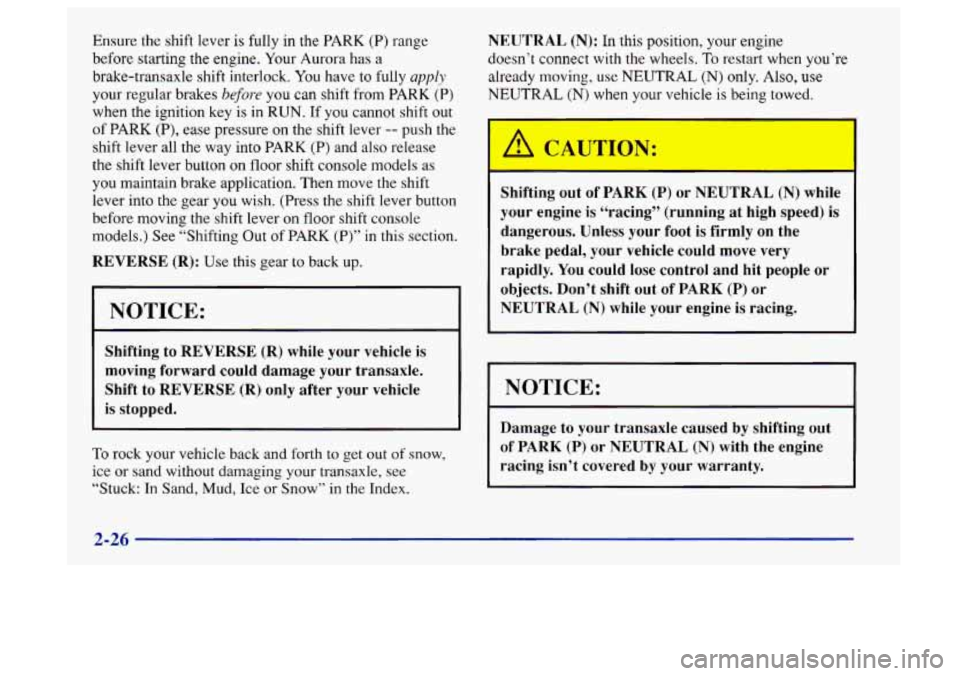
Ensure the shift lever is fully in the PARK (P) range
before starting the engine. Your Aurora has a
brake-transaxle shift interlock. You have to fully
apply
your regular brakes before you can shift from PARK (P)
when the ignition key is in RUN. If you cannot shift out
of PARK (P), ease pressure on the shift lever -- push the
shift lever all the way into PARK
(P) and also release
the shift lever button on floor shift console models as
you maintain brake application. Then move the shift
lever into the gear you wish. (Press
the shift lever button
before moving the shift lever on floor shift console
models.) See “Shifting Out
of PARK (P)” in this section.
REVERSE (R): Use this gear to back up.
NOTICE:
Shifting to REVERSE (R) while your vehicle is
moving forward could damage your transaxle.
Shift to
REVERSE (R) only after your vehicle
is stopped.
To rock your vehicle back and
forth to get out of snow,
ice or sand without damaging your transaxle, see
“Stuck:
In Sand, Mud, Ice or Snow” in the Index.
NEUTRAL (N): In this position, your engine
doesn’t connect with the wheels.
To restart when you’re
already moving, use NEUTRAL
(N) only. Also, use
NEUTRAL (N) when your vehicle is being towed.
Shifting out
of PARK (P) or NEUTRAL (N) while
your engine is “racing” (running at high speed) is
dangerous. Unless your foot is firmly on the
brake pedal, your vehicle could move very
rapidly.
You could lose control and hit people or
objects. Don’t shift out of PARK (P) or
NEUTRAL (N) while your engine is racing.
I NOTICE:
Damage to your transaxle caused by shifting out
of PARK (P) or NEUTRAL (N) with the engine
racing isn’t covered by your warranty.
2-26
Page 84 of 404
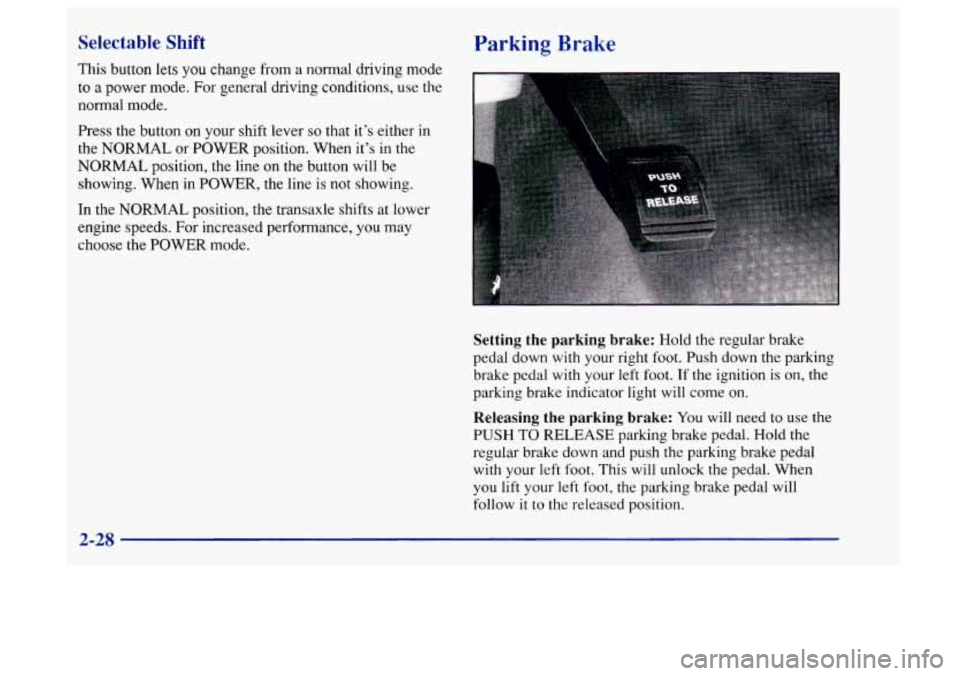
Selectable Shift
This button lets you change from a normal driving mode
to a power mode.
For general driving conditions, use the
normal mode.
Press the button
on your shift lever so that it’s either in
the
NORMAL or POWER position. When it’s in the
NORMAL position, the line on the button will be
showing. When in POWER, the line is not showing.
In the NORMAL position, the transaxle shifts at lower
engine speeds. For increased performance,
you may
choose the POWER mode.
Parking Brake
Setting the parking brake: Hold the regular brake
pedal down with your right foot. Push down the parking
brake pedal with your left
foot. If the ignition is on, the
parking brake indicator light will come
on.
Releasing the parking brake: You will need to use the
PUSH
TO RELEASE parking brake pedal. Hold the
regular brake down and push the parking brake pedal with your left foot. This will unlock the pedal. When
you lift your left foot, the parking brake pedal will
follow
it to the released position.
2-28
Page 86 of 404
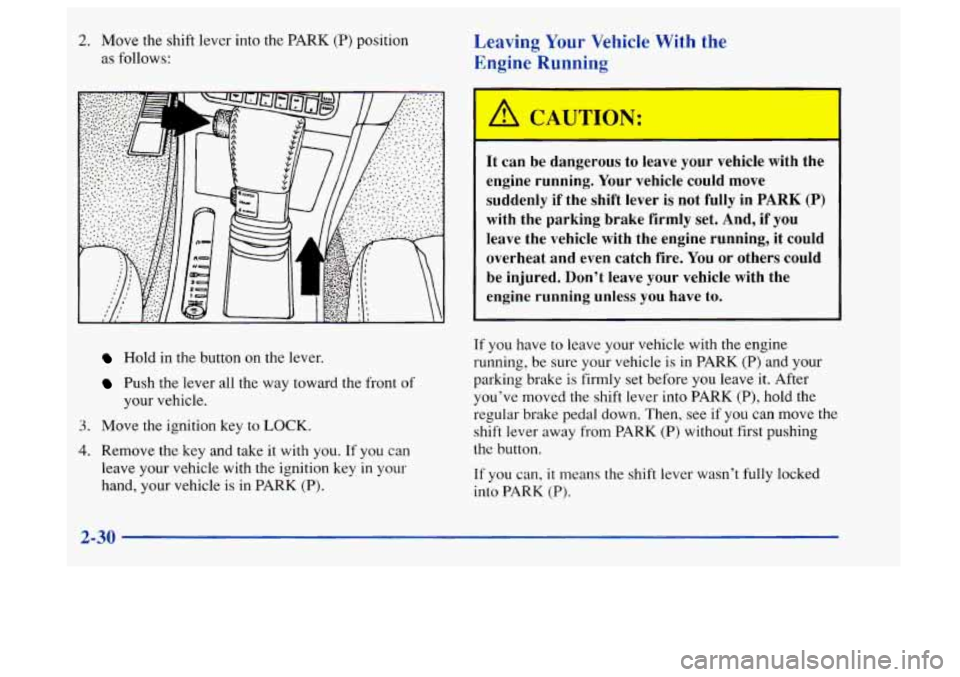
2. Move the shift lever into the PARK (P) position
as
follows:
Leaving Your Vehicle With the
Engine Running
It can be dangerous to leave your vehicle with the
engine running. Your vehicle could move
suddenly if the shift lever is not fully in PARK
(P)
with the parking brake firmly set. And, if you
leave the
ehicle with the engine running, it could
overheat and even catch fire.
You or others could
be injured. Don’t leave your vehicle with the
engine running unless you have to.
Hold in the button on the lever.
Push the lever all the way toward the front of
your vehicle.
3. Move the ignition key to LOCK.
4. Remove the key and take it with you. If you can
leave your vehicle with the ignition key
in your
hand, your vehicle is in PARK
(P).
If you have to leave your vehicle with the engine
running, be sure your vehicle is in PARK (P) and your
parking brake is firmly set before you leave it. After
you’ve moved the shift lever into PARK
(P), hold the
regular brake pedal down. Then, see if you can move the
shift lever away from PARK (P) without first pushing
the button.
If you can,
it means the shift lever wasn’t fully locked
into PARK
(P).
2-30
Page 87 of 404
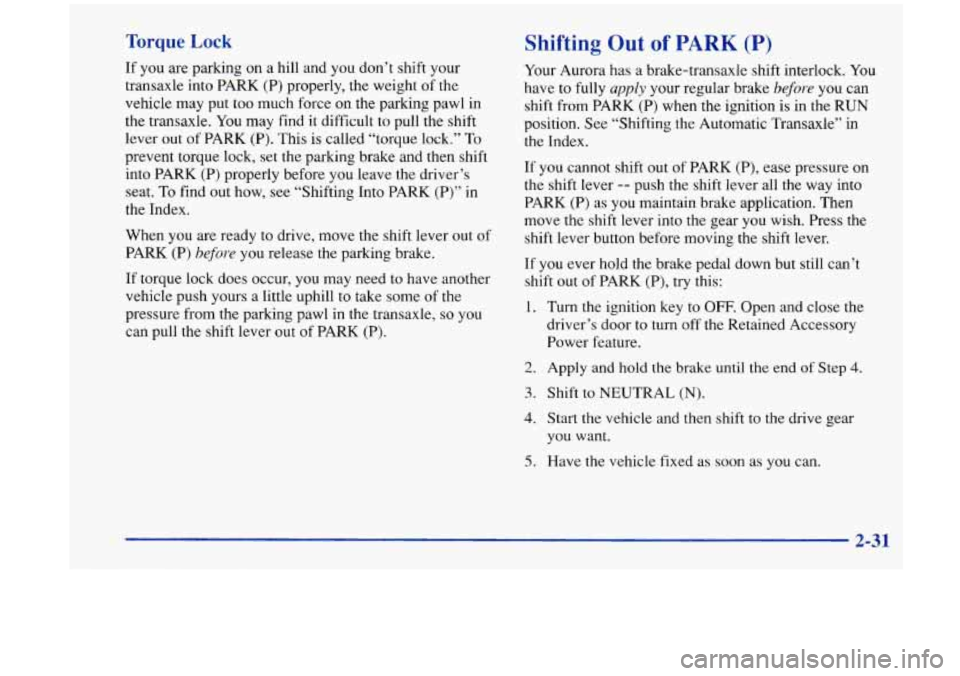
Torque Lock
If you are parking on a hill and you don’t shift your
transaxle into PARK (P) properly, the weight of the
vehicle may put too much force on the parking pawl in
the transaxle. You may find it difficult to pull the shift
lever out of PARK (P). This is called “torque lock.”
To
prevent torque lock, set the parking brake and then shift
into PARK (P) properly before you leave the driver’s
seat. To find out how,
see “Shifting Into PARK (P)” in
the Index.
When you are ready
to drive, move the shift lever out of
PARK (P)
before you release the parking brake.
If torque lock does occur, you may need to have another
vehicle push yours a little uphill to take some
of the
pressure from the parking pawl in the transaxle,
so you
can pull the shift lever out
of PARK (P).
Shifting Out of PARK (P)
Your Aurora has a brake-transaxle shift interlock. You
have
to fully apply your regular brake before you can
shift from PARK (P) when the ignition is
in the RUN
position. See “Shifting the Automatic Transaxle” in
the Index.
If you cannot shift out of PARK (P), ease pressure on
the shift lever
-- push the shift lever all the way into
PARK (P) as you maintain brake application. Then
move the shift lever into the gear you wish. Press the
shift lever button before moving the shift lever.
If you ever hold the brake pedal down but still can’t
shift out
of PARK (P), try this:
1.
2.
3.
4.
5.
Turn the ignition key to OFF. Open and close the
driver’s door to turn off
the Retained Accessory
Power feature.
Apply and hold the brake until
the end of Step 4.
Shift to NEUTRAL (N).
Start the vehicle and then shift to the drive gear
you want.
Have the vehicle fixed as
soon as you can.
2-31
Page 90 of 404
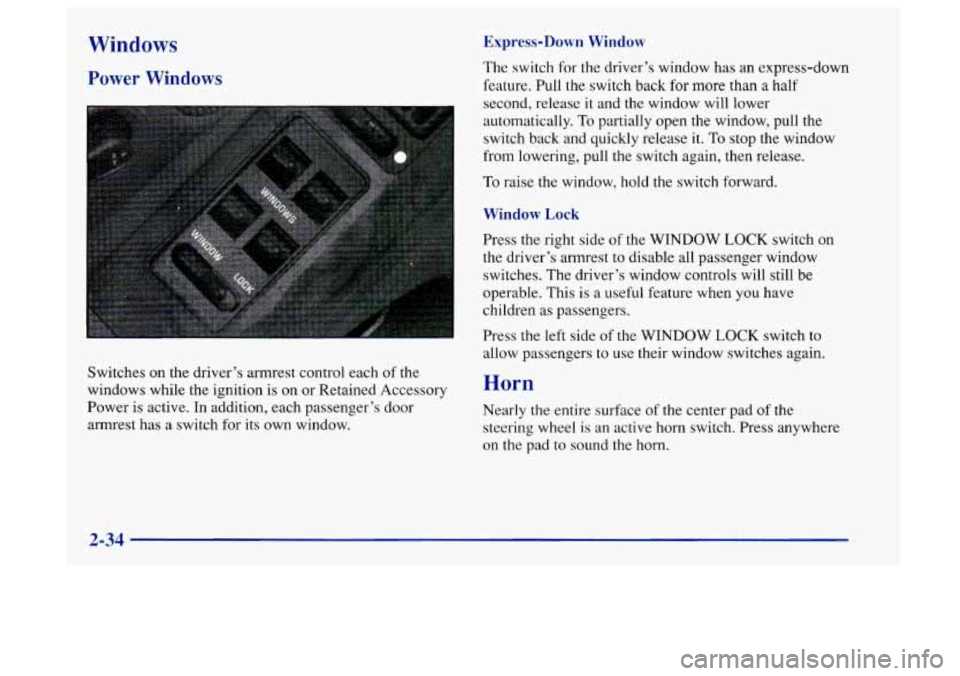
Windows
Power Windows
Switches on the driver’s armrest control each of the
windows while the ignition is on or Retained Accessory
Power is active. In addition, each passenger’s door
armrest has
a switch for its own window.
Express-Down Window
The switch for the driver’s window has an express-down
feature. Pull the switch back
for more than a half
second, release it and the window will lower
automatically.
To partially open the window, pull the
switch back and quickly release it.
To stop the window
from lowering, pull the switch again, then release.
To raise the window, hold the switch forward.
Window Lock
Press the right side of the WINDOW LOCK switch on
the driver’s armrest to disable all passenger window
switches. The driver’s window controls will still be
operable. This is a useful feature when you have
children as passengers.
Press the left side of the WINDOW
LOCK switch to
allow passengers
to use their window switches again.
Horn
Nearly the entire surface of the center pad of the
steering wheel
is an active horn switch. Press anywhere
on the pad to sound the horn.
2-34
Page 91 of 404
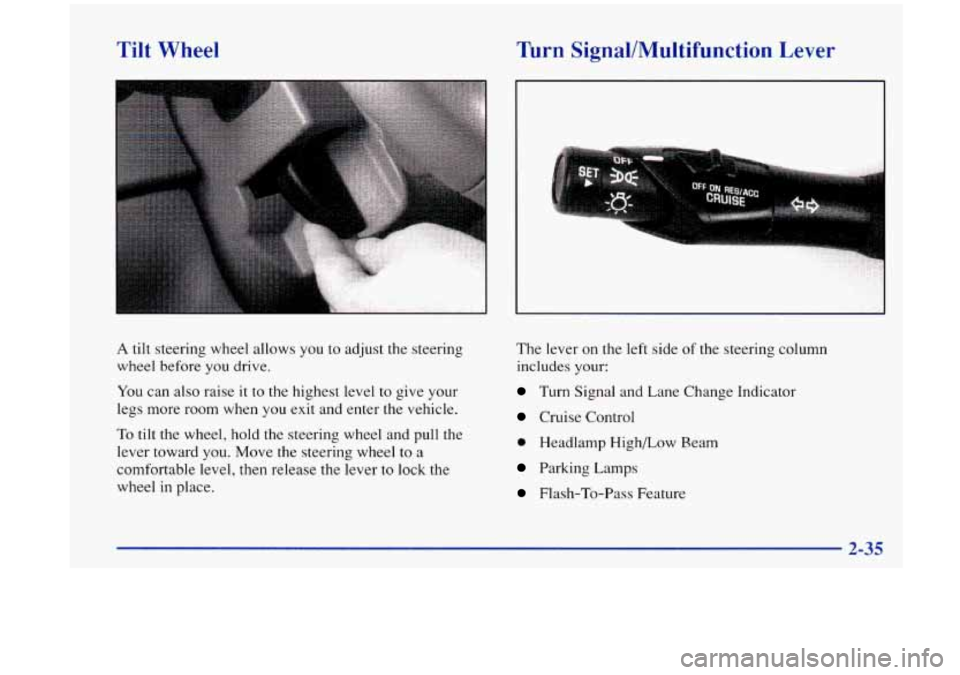
Tilt Wheel hrn Signal/Multifunction Lever
A tilt steering wheel allows you to adjust the steering
wheel before you drive.
You can also raise it to the highest level to give your
legs more room when you exit and enter the vehicle.
To tilt the wheel, hold the steering wheel and pull the
lever toward you. Move the steering wheel
to a
comfortable level, then release the lever to lock the
wheel in place. The
lever on the left side
of the steering column
includes your:
Turn Signal and Lane Change Indicator
Cruise Control
0 Headlamp Highbow Ream
Parking Lamps
Flash-To-Pass Feature
Page 96 of 404
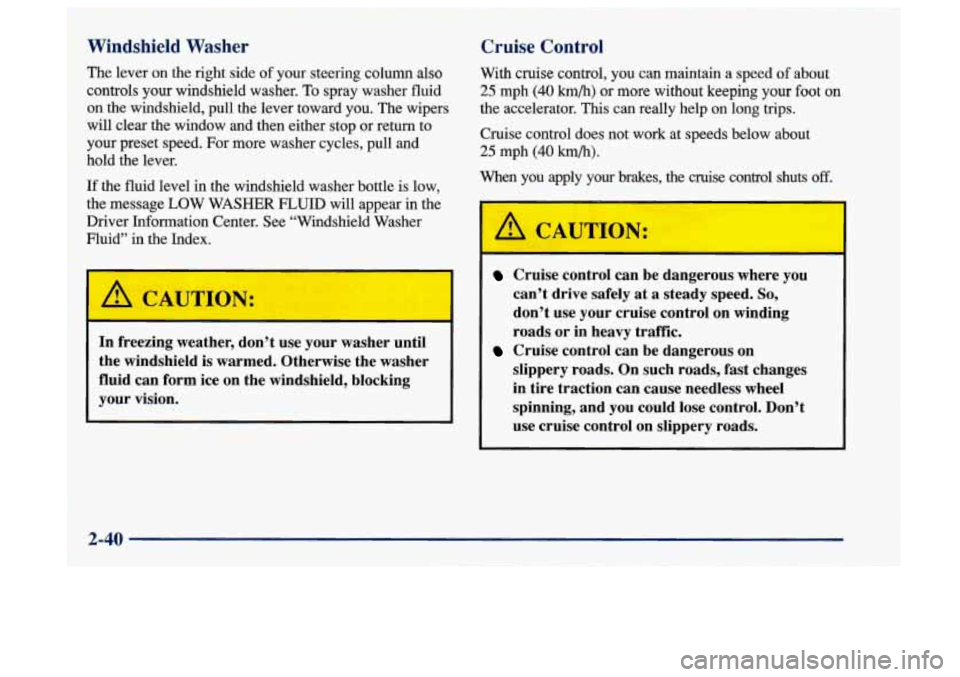
Windshield Washer
The lever on the right side of your steering column also
controls your windshield washer.
To spray washer fluid
on the windshield, pull the lever toward you. The wipers
will clear the window and then either stop or return to
your preset speed. For more washer cycles, pull and
hold the lever.
If the fluid level in the windshield washer bottle is low,
the message
LOW WASHER FLUID will appear in the
Driver Information Center. See “Windshield Washer
Fluid” in the Index.
/d CAUTldN:
In freezing weather, don’t use your washer until
the windshield
is warmed. Otherwise the washer
fluid can form ice on the windshield, blocking
your vision.
Cruise Control
With cruise control, you can maintain a speed of about
25 mph (40 km/h) or more without keeping your foot on
the accelerator.
This can really help on long trips.
Cruise control does not work at speeds below about
25 mph (40 km/h).
When you apply your brakes, the cruise control shuts off.
m
A CAUT1b.J:
Cruise control can be dangerous where you
can’t drive safely at a steady speed. So,
don’t use your cruise control on winding
roads or in heavy traffic.
slippery roads. On such roads, fast changes
in tire traction can cause needless wheel
spinning, and you could lose control. Don’t
use cruise control on slippery roads.
Cruise control can be dangerous on
2-40
Page 103 of 404
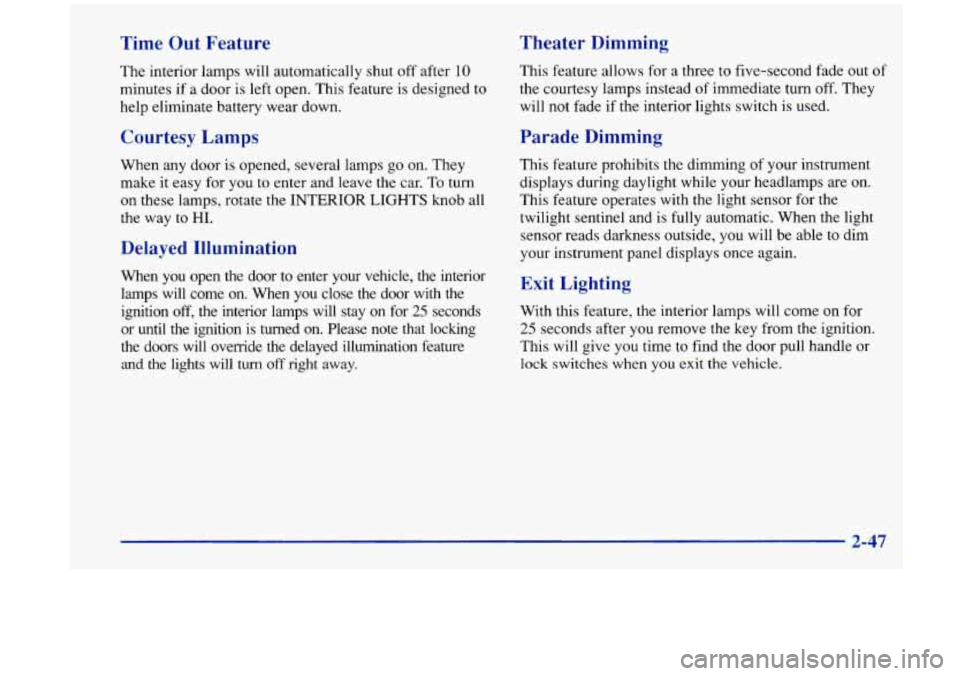
Time Out Feature Theater Dimming
The interior
lamps will automatically shut off after 10
minutes if a door is left open. This feature is designed to
help eliminate battery wear down.
Courtesy Lamps
When any door is opened, several lamps go on. They
make it easy for you to enter and leave the car. To turn
on these lamps, rotate the
INTERIOR LIGHTS knob all
the way to
HI.
Delayed Illumination
When you open the door to enter your vehicle, the interior
lamps will come on. When you close the door with the
ignition
off, the interior lamps will stay on for 25 seconds
or until the ignition is turned on. Please note that locking
the doors will override the delayed illumination feature
and the lights will turn off right away. This feature allows for
a three to five-second fade out
of
the courtesy lamps instead of immediate turn off. They
will not fade if the interior lights switch
is used.
Parade Dimming
This feature prohibits the dimming of your instrument
displays during daylight while your headlamps are on.
This feature operates with the light sensor for
the
twilight sentinel and is fully automatic. When the light
sensor reads darkness outside, you will be able to dim
your instrument panel displays once again.
Exit Lighting
With this feature, the interior lamps will come on for
25 seconds after you remove the key from the ignition.
This will give you time to find the door pull handle or
lock switches when you exit the vehicle.
2-47
Page 104 of 404
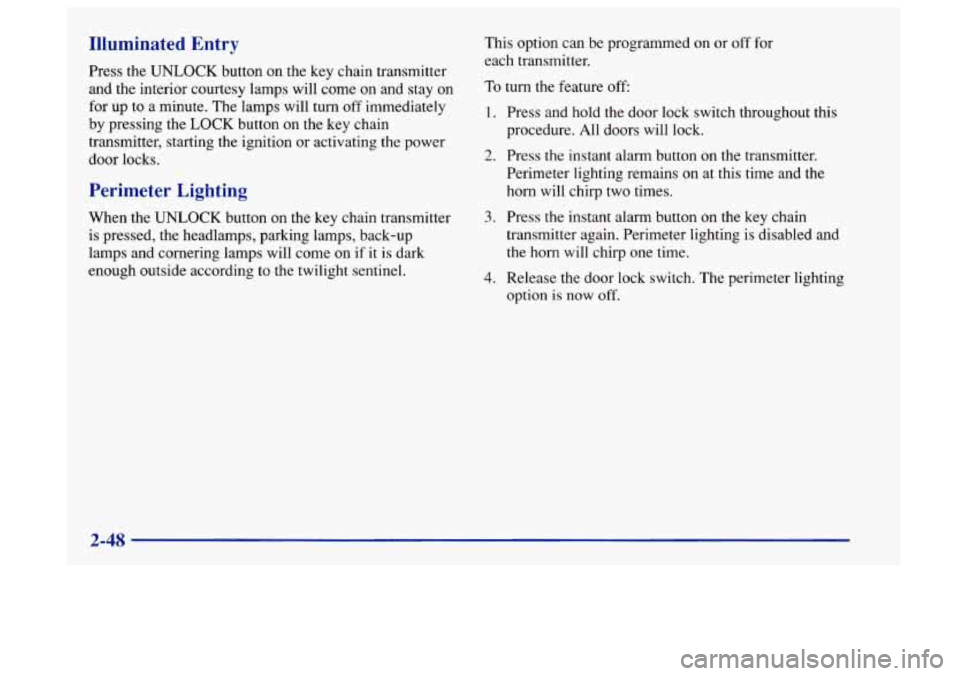
Illuminated Entry
Press the UNLOCK button on the key chain transmitter
and the interior courtesy lamps will come on and stay on
for up
to a minute. The lamps will turn off immediately
by pressing the
LOCK button on the key chain
transmitter, starting the ignition or activating the power
door locks.
Perimeter Lighting
When the UNLOCK button on the key chain transmitter
is pressed, the headlamps, parking lamps, back-up
lamps and cornering lamps will come on if it is dark
enough outside according to the twilight sentinel.
This option can be programmed on or off for
each transmitter.
To turn the feature off
1. Press and hold the door lock switch throughout this
procedure. All doors will lock.
2. Press the instant alarm button on the transmitter.
Perimeter lighting remains on at this time and the
horn will chirp two times.
3. Press the instant alarm button on the key chain
transmitter again. Perimeter lighting is disabled and
the horn will chirp one time.
4. Release the door lock switch. The perimeter lighting
option is now
off.
2-48
Page 105 of 404

To turn the feature on: Front Reading Lamps
1.
2.
3.
4.
Press and hold the door lock switch throughout this
procedure. All doors will lock.
Press the instant alarm button
on the key chain
transmitter. Perimeter lighting remains off at this
time and the
horn will chirp one time.
Press the instant alarm button on the transmitter
again. Perimeter lighting is now enabled and the
horn will chirp two times.
Release the door lock switch. The perimeter lighting
option is now on.
These lamps and the interior courtesy lamps will come
on when you open a door. They will turn off when you
turn on
the ignition. If the door is left open, they will
turn off after about
10 minutes.
To turn
on the reading lamps when the doors are closed,
press the button behind the lamp you want on. Press
it
again to turn the lamp off.
These lamps work even when the ignition is off. To avoid
draining your vehicle's battery, be sure to
turn off all front
and rear reading lamps when leaving your vehicle.
2-49